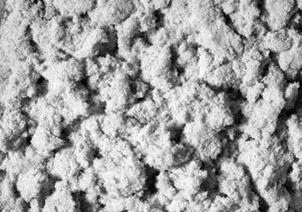Loose Cellulose Fibers
Loose cellulose threads (Figure 4.4) have the longest history of application. One of their advantages is that they become effective immediately after mixing them with aggregate and binder. They should be protected from moisture as they are highly hydrophilic and easily absorb water. Wet fibers are not able to absorb the binder and therefore are not effective.
Loose cellulose fibers are supplied in bags of thermo-shrinkable plastic. The mass of fiber per bag can be prearranged with the manufacturer and should be tailored to the batch volume of a given batch from an asphalt-mixing plant. An automatic
|
FIGURE 4.4 An example of loose cellulose fibers. (Photo courtesy of J. Rettenmaier & Sohne GmbH + Co. KG, Germany.) |
metering process for SMA production in an asphalt-mixing plant has been possible for some time now; loose fibers are delivered by autotankers and stored in a silo. During mix production, they are blown into the pugmill via an automatic system. The same pneumatic metering system can be used in drum-mixing plants.
When adding loose fibers, it is worthwhile to remember the following:
• The time at which the fibers are batched into the mixer is very important; bags should be emptied into the mixer during the dry mixing time, prior to binder loading.
• An excessive increase in the dry (binder-free) mixing time may lead to grinding of the fibers into dust by the aggregate, limiting the effectiveness of the stabilizing action.
• Loose fibers are very sensitive to moisture and therefore should be properly protected and stored; wet fibers lose their absorbing power.
When testing SMA mixtures in a laboratory, loose fibers may be treated without any special precautions. A mechanical mixer is not required.







Leave a reply